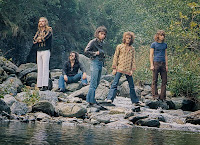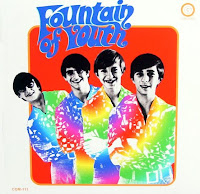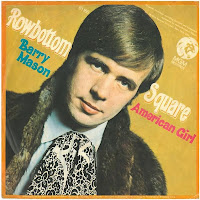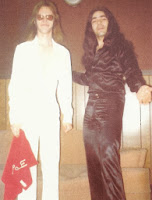Download from: [
mf] or [
mg]
password:
tdatsWelcome to TDATS 95! It's that time again......another batch of doom-laden misery awaits. Now a tradition here, partly in honour of 'The DooM That Time Forgot' series that was made by RYM friend LibertyCaps a few years ago. For some links to his volumes, and related ones from me, check out the
DTTF round-up and check out my most recent doom special:
Vol62: The DooM That Time Reprised.
Here we have a diverse mix from all over the world. Some of the tracks are from heavy psych/hard rock albums which I'd recommend to look out for, like those of Fort Mudge Memorial Dump, The Petards, Atlantis Philharmonic, Icecross, Shuttah and Alphataurus. Then we have the more unexpected inclusions like the Australian jazz experimentalists Company Caine and a single from the pop writer Barry Mason.
Once again I have used the art of the talented Virgil Finlay for the cover. Look him up and prepare to be amazed at his vision of dimensions unseen and workings beyond reality.
Tracks
01. Alphataurus [Italy] - Dopo L'Uragano (1973)
from album 'alphataurus'
02. Grupa SOS [Serbia] - Magnovenje (1974)
single
03. Fountain of Youth [US] - Witness People (1969)
single
04. Fort Mudge Memorial Dump [US] - The Singer (1969)
from album 'fort mudge memorial dump'
05. Barry Mason - [UK] Over The Hills and Far Away (1966)
single
06. The Petards - [Germany] Big Boom (1971)
from album 'pet arts'
07. Missus Beastly - [Germany] Remember - Sweet Girl (1973)
from album 'super rock - made in germany'
08. The Collectors [Canada] - Teletype Click (1969)
from album 'grass and wild strawberries'
09. Atlantis Philharmonic [US] - Atlas (1974)
from album 'atlantis philharmonic'
10. Company Caine [Australia] - The Day Superman Got Busted (1971)
from album 'a product of a broken reality'
11. Icecross [Iceland] - 1999 (1973)
from album 'icecross'
12. Shuttah [UK] - Bull Run (1971)
from album 'the image maker vol 1 & 2'
references/credits:
 |
| Alphataurus |
Alphataurus introduce this set with a fittingly ominous thunder storm, from there the song develops with all the drama and passion you'd expect from Italian prog. They were from Milan and their 1973 s/t album was produced by the Magma label, founded by Vittorio De Scalzi (singer/guitarist) of one of Italy's most important bands,
New Trolls (see
Vol37). It had a great triple-gatefold cover with a portentous image of a desolate landscape showing a dove of peace dropping bombs, industrial pollution and nuclear war. A pretty clear indicator of the band's world-view at the time.
 |
| Alphataurus gatefold LP (1973) |
According to
Discogs the line-up that recorded their album was: Alfonso Oliva (bass), Giorgio Santandrea (Drums,percussion), Guido Wasserman (Guitar), Pietro Pellegrini (Piano, Organ, Moog, Vibraphone, Spinet) and Michele Bavaro (Vocals). The band are still a going concern and you can check their recently updated site at
www.alphataurus.it
 |
| Grupa SOS |
A rare inclusion of a Serbian band is next;
Grupa SOS. I have not found much information on them, but a little was revealed with help from Ipsissimus Mocata in the TDATS
fb group. He pointed out that some members re-appeared in the later-'70s as 'Riblja Čorba', a great band which I had already been saving up for further east-european comps, with the common members being Rajko Kojić (guitar, 1977) and Vicko Milatović (drums, 1977). The track here is a thick slice of prime Black Sabbath worship, some of the most faithful you'll ever hear from the times and full of that evil guitar tone! The rest of Grupa SOS was Miroslav Aleksić Miša (bass, vocals), Dragan Štulović Štuks (guitar, 1972-77), Aleksandar Tasić Tasa (guitar, 1972) and Stevan Stevanović Stiv (drums, 1972-77).
 |
| Fountain of Youth LP (unreleased) |
The Fountain Of Youth are next, a '60s psych band that made only a few singles (though RYM says they made an unreleased album). The lineup was Jimmy Panza (lead vocals & drums, Gary Itri (bass & vocals), Gary Jenschke (lead guitar & vocals) and Ken Molberg (rhythm guitar & vocals). The track I used could be described as sludge-pop, with it's prominent bass combining with the fuzz to create a thick bottom end. I found some great info over at
Flower Bomb Songs : "They were a teen group from Fredericksburg, Texas who previously recorded as The Crossfires releasing the following 45: 'Who'll Be The One'/'Making Love Is Fun' (Tower 278)... They came to the attention of the Colgems label who signed them in March 1968 (there is a mention in a Billboard magazine from this time)..
 |
| The Fountain of Youth |
|
|
|
|
|
Looking at the promo pic of The Fountain Of Youth it shows the teenagers to be a clean cut, square looking combo in psychedelic shirts. By the time of this single, their 4th for Colgems, I'd be surprised if they looked as wholesome as this. 'Liza Jane' was released in April 1969 and is typical bubblegum pop of that time period. The jewel is the heavy psych flip 'Witness People'... There isn't that much information around about The Fountain Of Youth but they seemingly had a lead singing drummer! Richard Podolor produced their Colgems singles. He also worked with psych outfit The Glass Family, The Starfires, The Standells, The Chocolate Watch Band and many more I'm sure."
The Fort Mudge Memorial Dump was a recent find for me, and I have to say their s/t 1969 album is something to get excited about. A great combination the heaviest "Boston Sound" psych you'll find, with Caroline Stratton's vocals resembling Grace Slick and some killer guitar workouts from Dean Keady, which in places resemble Hendrix at his sludgy-wah'd best. The track I used here is one of the heaviest and longest from the album, and features a cool emotive male vocal performance which I presume is from one of the other listed members: James Deptula, Dave Amaral or Richard Clerici, but I don't know which. For such a well formed, great-sounding record there is little information to go by but here's what is stated about them: "They were from Walpole, Massachusetts, that started playing by 1969, gathering a good number of fans. They got filed into the “Boston Sound”, among the Ultimate Spinach, the Beacon Street Union, Orpheus, Tangerine Zoo, ect."
.JPG) |
| Barry Mason (circa 1967) |
Barry Mason is an English popular music song-writer who also sung on occasion, he had a hand in some very famous songs, like Tom Jones' "Delilah" and even an Elvis song, "
Girl Of Mine", so he doesn't really come under the banner of obscure/unappreciated artist, but I've included his 1966 track "Over The Hills and Far Away" as it's got a definite doom-laden atmosphere and I love it. A bit of a curve ball, ripe for a heavy cover maybe? Here's Barry
performing recently and here's an interview mentioning some or the greats he's worked with:
www.songwriter.co.uk/page64.html
 |
| The Petards |
The Petards are a German band from Schrecksbach (Schwalm City/Hesse) who I used once before back on
Vol82. Over the course of five solid albums they ran the well-worn path from 60s psych, to progressive/hard rock. They have a
web site and have played with a close-to-original lineup as recently as 2009. 1972's 'Pet Arts' LP is probably of most interest to TDATS, with brilliant stuff like "
Flame Missing Light" and the track I have used here, "Big Boom". They also recorded under the psudonym Flittermouse, and made an album of CCR covers as 'Zonk'.
The '
Missus Beastly' included here are a bit of an enigma. The story goes thus: In 1971 a guy called Henry Fromm posed as the drummer, flautist and even manager of the original German group "
Missus Beastly", although they had never met him. Their 1970 debut album was unsuccessful. Soon after, Henry had the album illegally re-released on a budget label. Then he started his own group, stealing the name, and made two LPs and three singles under the name "Missus Beastly" on his own label. Nobody has ever heard of him again. In 1974 the real Missus Beastly reformed after a hiatus and made two more albums.
 |
Henry Fromm's
Missus Beastly
|
All this caused me a lot of confusion, after hearing some of the singles from the 'bogus' band and really liking them I wanted to know more and found what was apparently two different-sounding German bands from the same period, with some connection that went further than just sharing the same name, that didn't quite make sense.
I have used a track called "Remember - Sweet Girl" from a live album '
Im Garten des Schweigens - Spinatwachtel' released by Henry Fromm's version of the band. I must give huge thanks to a guy called Gunnar Bülow who contacted me via Youtube, clearing up the story of the bands and supplying me with the song, thanks man!
 |
| The Collectors 1969 |
Vancouver's
The Collectors are another band here with a bit of an unexpected appearance of doom. The track I have used is from their second album, which was based on a hit stage-play of the same name: 'Grass and Wild Strawberries' by
George Ryga, with Ryga writing the lyrics. Guitarist Bill Henderson was later in
Chilliwack. The Collectors first hit was '
Lydia Purple' and I am pleasently surprised to realise that the song has appeared in TDATS before, on
Vol16 as a cover by Holland's Cargo.
 |
| Atlantis Philharmonic |
Cleveland, Ohio's
Atlantis Philharmonic was a duo that made an unusual album in 1974. A well-produced concept piece which was equal parts Sabbath doom and Styxian Midwest prog pretensions, with epic themes and song lengths to match. The song used here, 'Atlas', begins with militaristic stomp and continues with chugging riffs between the prog-pomp verses. The LP was self-recorded and released after a lack of label interest, and a second album was recorded too. All instrumentation was laid-down by only two guys; Joe DiFazio (organ, pianos, harpsichord, Mellotron, Moog, guitar, bass, bass pedals, lead vocals) and Royce Gibson (percussion, backing vocals). Reportedly the band supported some big names like Stxy, Wishbone Ash and King Krimson. There is a small web site regarding the band, that has a link to buy their second album, and some extra info which states that they found a third member Roger Lewis, which would explain how they must have managed to perform such a full sound live:
atlantisphilharmonic.comAccording to RDTEN1 at
RYM, "By the early-'80s DiFazio had largely dropped out of music. He obtained a masters degrees in computer technology from Indiana State University, though he also found time to complete a music degree. He is currently a professor of new media and computer technology at Indiana State University."
 |
| Gulliver Smith |
Melbourne's
Company Caine were another unusual band, that mixed blues and psych with horns. I'm very happy to have just found a live clip of the song I have used here, 'The Day Superman Got Busted':
youtu.be/WvFVn8GDAv8 Here's a snippet from the extensive article over at
Midoztouch: "[singer] Gulliver Smith's stage presence helped to earn Company Caine renown for their performances, and as the group came together they amassed a strong set of strikingly original material co-written by Gulliver, Russell Smith (guitar) and Jerry Noone (sax). They became established as one of the leading attractions on the Melbourne 'head' circuit, gigging alongside bands like Spectrum, Sons of the Vegetal Mother, Tully and the (new) Aztecs.
 |
| Company Caine LP 1971 |
In the words of Ian McFarlane, "... the band's music was more expansive, more 'out there' than just about every band of the day". But this should not be taken to mean that the music was wilfully obscure or 'difficult'. In fact, notwithstanding the 'freaky' and experimental elements, it was a unique amalgam of rock, pop, blues, soul, R&B, jazz and avant-garde that was both challenging and accessible. Another key feature was the surreal humour that pervaded their work. The fact remains that their music could - and should - have reached a far wider audience."
 |
| Icecross |
It's about time Iceland's
Icecross appeared on TDATS! The first time I heard the album I thought it was one of those releases with a dubious claim as to the year it was made because it doesn't sound quite like anything else from it's time, which is claimed to be around 1972/3. It seems to have been taken straight to the heart of those who are searching for some direct link between early hard rock and what is now known as extreme metal and the likes of satanic black metal. I can see what would lead to this, the atheistic sentiments of tracks like '
Jesus Freaks' and the doomy, dissonant and jarring riffs. There's now an informative site for the band here:
icecross.net where you can read about how Axel Einarsson (guitar, vocals), Ómar Óskarsson (bass, vocals) and Ásgeir Óskarsson (drums, vocals) got together. I would regard it as a must-hear album, and whether you like or not you will have to agree it's unique, for it's sound and especially it's country of origin!
 |
| Shuttah LP - Shadoks label |
Coming to an end for this volume,
Shuttah is a mystery indeed. The only available album has been issued on the ever-reliable Shadoks label, on Vinyl and CD. All I can discover and all that anybody seems to know is that this double album was recorded for Virtigo at the
IBC studio in London. This studio was used by some of the biggest names, such as The Beatles and The Stones, so it is suspected that who ever Shuttah were, they were not amatures. The album is a progressive mix of psych, blues and experimental sound effects which together makes for an early conceptual progressive rock album, the whole thing is loosly themed around the 2nd world war. The production of the album sounds very professional which is another indicator that it was a serious attempt with money behind it.
 |
| IBC studio, London |
The former IBC owner, Geoff Oliver, claims to have no memory of it at all. What I have not been able to find out yet is how anybody knows the scant details that are stated, such as the year of 1971 and the Vertigo/IBC connection. If anybody out there knows more, drop me a line. Here is what the Shadoks label has to say: "We have searched for a very long time, including an interview with the owner of IBC studios in London where The Who and also The Beatles recorded. We have enquired with copyright control in UK, nothing. We know nothing. We're only aware of one pair of acetates, that are in the hands of a collector." This begs the question, can we really confirm any of what little is known? At the moment, no.
Thanks to all those that have commented and support this blog, and those that have contributed. Lastly, thanks for listening! Rich
Share via:















.jpg)





